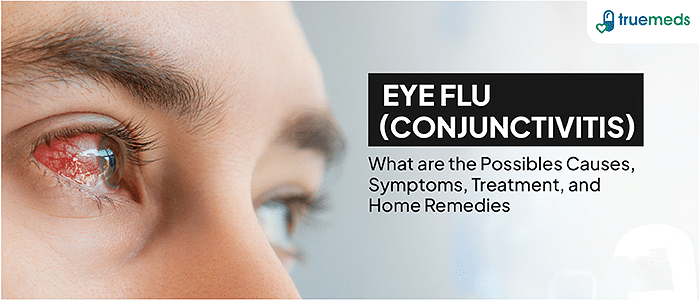Eye Flu (Conjunctivitis): Causes, Symptoms, Treatment, and Home Remedies
Last updated on : 19 Sep, 2024
Read time : 11 min
Introduction
Conjunctivitis, more commonly referred to as eye flu, is a highly communicable eye infection characterised by irritation and inflammation of the organ. Furthermore, it is transmitted and may spread from one individual to another easily, regardless of whether it is caused by a virus, bacteria, or allergens, particularly in crowded places. Therefore, it is very important to recognise the disease at an early stage and learn the ways of treatment and prevention of the disease for maintaining good health and well-being of the eyes. The article explains the cause and symptoms, their effective treatments, and home remedies that would help you keep up and recover from this annoying state of your eye.
What is Eye Flu?
Eye flu, or conjunctivitis flu, is an inflammation of the conjunctiva, a thin and transparent membrane that covers the white portion of each eye and lines the inside of the eyelids. It is a very infectious and pretty common disease that could easily get transmitted from one person to another in crowded places. The flu in the eyes can be caused by viruses, bacteria, allergens, and other irritants. These will make one’s eyes ache and appear red.
Causes of Eye Flu
The eye flu causes depend on the type of conjunctivitis involved. The most common cause is a viral eye infection, often concurrent with an upper respiratory infection like the flu or common cold. Bacterial infection, allergens like pollen or dust or pet dander, and even irritants such as smoke or chemicals may also lead to conjunctivitis. The conjunctivitis determines what kind of treatment to apply.
Also Read: Home Remedies for Cold & Flu
Symptoms and Signs of Eye Flu (Conjunctivitis)
Eye flu symptoms include some signs that define the ailment. A few of the key symptoms of Eye Flu include:
- Redness: The eyes turn red and bloodshot due to inflammation.
- Itchiness: Commonly, a person feels itchiness in the eye.
- Lacrimation: Excessive watering or tearing of the watery eye is always experienced.
- Grittiness: Many people will feel like there is sand or grit in their eyes.
Among others, additional symptoms of Eye Flu include:
- Discharge: A sticky discharge is formed which crusts at night, making the eyes sticky in the morning.
- Swollen Eyelids: The eyelids swell, further irritating the eyes.
- Photophobia: Lighting becomes particularly irritating or painful; this may include squinting or shutting the eyes frequently.
- Blurred Vision: Vision may blur due to temporary irritation/discharge.
These symptoms help to distinguish eye flu from the rest of the eye conditions. Therefore, identification of these signs at the early stage enables timely treatment, preventing the condition from getting out of hand and spreading to others.
For more information on related eye conditions, you may find it helpful to read about sore eyes and eye floaters, eye twitching as well as causes of dry eyes.
Diagnosis of Eye Flu
Eye flu diagnosis is mainly based on symptoms and physical examination of the eyes. A health expert may also swab the discharge of the eye to tell whether it is a viral or bacterial infection. This helps in choosing the most effective treatment plan to be initiated.
Treatment Options for Eye Flu
Eye flu treatment depends on the cause. The eye flu caused by bacteria may require an antibiotic prescription, while the viral conjunctivitis most often improves by itself with only supportive care. For allergic conjunctivitis, antihistamines and avoiding the allergen can manage it.
Medical Treatment For Eye Flu
Medical treatment for pink eye includes prescription eye flu medicine, such as antibiotic eye drops or ointments for bacterial pink eye. Here are some options for you:
- Antibiotic Eye Drops or Ointments: For bacterial conjunctivitis, a doctor may prescribe antibiotic eye drops or ointments to treat the infection. It’s important to use the medicine exactly as prescribed and finish the full course to make sure the infection is fully cleared. Some commonly prescribed antibiotics in India for treating bacterial conjunctivitis include Ciprofloxacin, Moxifloxacin, Ofloxacin, Chloramphenicol, and Gentamicin. These medications are effective in clearing the infection by targeting the bacteria responsible for the condition.
- Antiviral Medications: In severe cases of viral conjunctivitis, doctors may prescribe antiviral medications to help manage the infection. Some common examples include Acyclovir, and Ganciclovir.
- Antihistamines or Decongestants: If allergies are causing the eye flu, antihistamine eye drops or oral medicine can help reduce symptoms by calming the allergic reaction. Decongestant drops can also be used to ease redness and swelling. Examples include combination medicines like Alcaftadine + Benzalkonium Chloride.
- Steroid Eye Drops: In cases of severe eye inflammation, steroid eye drops may be given to reduce swelling and discomfort.
- Artificial Tears or Lubricants: Over-the-counter artificial tears can help soothe dry and irritated eyes. You can use these drops several times a day to keep your eyes moisturized and comfortable. Some common examples include Carboxy Methyl Cellulose or Sodium Carboxymethyl Cellulose.
Home Remedies for Eye Flu
Eye flu treatment at home would only require some simple but quite effective steps. Here are some steps to follow:
- Warm Compresses: Applying a warm compress can soothe discomfort and reduce inflammation.
- Artificial Tears: Using artificial tears helps prevent dryness and keeps the eyes moisturized.
- Good Hygiene Practices: Frequent handwashing and avoiding touching or rubbing the eyes are crucial to prevent the spread of infection.
- Adequate Home Care: For mild cases, these home remedies for eye flu can be effective in managing symptoms and promoting recovery.
You May Also Like: 7 Natural Ways To Improve Eyesight
Essential Tips for the Prevention of Eye Flu
Eye flu prevention is very important not only to prevent the spread of the infection to others but also to prevent its worsening in the case of an infected patient. Here are a few essential tips:
- Wash Your Hands: The simplest and most effective way of preventing the eye flu from spreading due to a virus or bacteria is frequent handwashing.
- Avoid Rubbing/Rubbing Your Eyes: By keeping one’s hands away from the eyes, one reduces the risk of introducing germs into the area of the eyes.
- Sterilise Common Services: Sterilise services such as doorknobs, light switches, and items used in common regularly to prevent infection.
- Avoid Scratching Your Eyes: Scratching may result in further irritation of the eye and spread the infection to the other eye.
- Protective Eyewear: In case you are working in a setting where chances of acquiring this infection are high, protective eyewear would prevent your eyes from external irritants or infective organisms.
- Stay away: Keep away from the infected person who has conjunctivitis to reduce your chances of getting the infection.
- Maintain Proper Hygiene with Contact Lenses: Clean and store the lenses as instructed to avoid eye flu and other infections.
You May Also Like: Eye Care Essentials: 5 Simple Tips for Healthy Vision
Complications of Untreated Eye Flu
If left untreated, this could then eventually result in different complications: it generates corneal ulcers, in the loss of vision, or in chronic conjunctivitis. Therefore, early treatment should be effected to prevent such outcomes.
You May Also Like: 10 Easy Tips to Improve Your Eyesight & Maintain Eye Health
Conjunctivitis versus Other Eye Infections
It is important to know when one is dealing with conjunctivitis and not some other eye infection. Whereas conjunctivitis basically affects the conjunctiva, other infections may engage deeper structures of the eye and need different approaches to treatment.
When to See a Doctor
See an eye doctor if you have severe symptoms in your eyes, persistent pain, vision changes, or when the condition does not seem to be improving with home care. Professional attention ensures the proper kind of treatment and proper prevention of complications.
Conclusion
Eye flu is a common but highly contagious condition that can cause significant discomfort. Understanding the eye flu causes, recognising eye flu symptoms, and knowing how to treat eye flu with both medical and home remedies can help you manage this condition effectively. By following proper hygiene practices and eye flu prevention tips, you can reduce your risk of infection and protect your eye health.
Get our easy-to-use Truemeds app for affordable medicines. Just upload your prescription to access both brand-name and substitute drugs. Save money on your purchases and enjoy the added convenience of free home delivery on eligible orders across India*.
Disclaimer
The information in this article has been checked for accuracy, but it’s best to talk to a doctor before trying any medicines, supplements, or information mentioned here.
Frequently Asked Questions (FAQs)
To treat eye flu at home, apply cold compresses to soothe irritation, keep your eyes clean by gently wiping away discharge, and use over-the-counter lubricating eye drops to relieve dryness. Ensure you maintain proper hygiene to prevent spreading the infection.
The best medicine for eye flu depends on the cause. For bacterial conjunctivitis, antibiotic eye drops like Ciprofloxacin may be prescribed, while antihistamine drops are used for allergic conjunctivitis. Consult a doctor for the appropriate treatment.
Recovery from eye flu typically takes about 1 to 2 weeks, depending on the severity of the infection and the treatment used. Viral conjunctivitis may take longer to resolve compared to bacterial infections.
During eye flu, consume foods rich in Vitamin A and C, such as carrots, spinach, and citrus fruits, to boost your immune system. Also, stay hydrated by drinking plenty of water.
Eye flu is spreading in India due to increased exposure in crowded places, poor hygiene practices, and the contagious nature of the infection, especially during the monsoon season.
The fastest way to cure an eye infection is to consult a doctor for appropriate medication, such as antibiotics or antiviral eye drops, and follow good hygiene practices to prevent the spread.
Yes, eye flu can cause a mild fever, especially if it’s part of a broader viral infection, such as the flu.
No, eye flu does not spread by looking. It spreads through direct contact with infected secretions or contaminated surfaces.
Yes, you can use a phone during eye flu, but limit screen time to avoid eye strain, which can worsen symptoms.
Yes, eye flu often resolves on its own within 1 to 2 weeks, especially if it’s viral. However, seeking medical advice can help speed up recovery and prevent complications.
References
- Hashmi, M. F., Gurnani, B., & Benson, S. (2024, January 26). Conjunctivitis. StatPearls – NCBI Bookshelf. https://www.ncbi.nlm.nih.gov/books/NBK541034/
- Solano, D., Fu, L., & Czyz, C. N. (2023, August 28). Viral Conjunctivitis. StatPearls – NCBI Bookshelf. https://www.ncbi.nlm.nih.gov/books/NBK470271/
- Overview: Conjunctivitis. (2021, December 8). InformedHealth.org – NCBI Bookshelf. https://www.ncbi.nlm.nih.gov/books/NBK279313/
- Quick Home Remedies for Pink Eye. (2023, April 27). American Academy of Ophthalmology. https://www.aao.org/eye-health/diseases/pink-eye-quick-home-remedies
Disclaimer
Our healthcare experts have carefully reviewed and compiled the information presented here to ensure accuracy and trustworthiness. It is important to note that this information serves as a general overview of the topic and is for informational purposes only. It is not intended to diagnose, prevent, or cure any health problem. This page does not establish a doctor-patient relationship, nor does it replace the advice or consultation of a registered medical practitioner. We recommend seeking guidance from your registered medical practitioner for any questions or concerns regarding your medical condition.
Popular Articles
Recommended Articles
Recent Articles
Top-Selling Medicines:
...View more
Top-Selling OTC:
...View more
Subscribe
Claim your complimentary health and fitness tips subscription and stay updated on our newest promotions.
Download Truemeds
Manage your health with ease Download Truemeds today!Get easy access to medicine refills, health information, and more. With our app, you'll never have to wait in line again. Download now and start taking control of your health.

Contact Us
Our customer representative team is available 7 days a week from 9 am - 9 pm.
v3.5.0
Our Payment Partners




























































